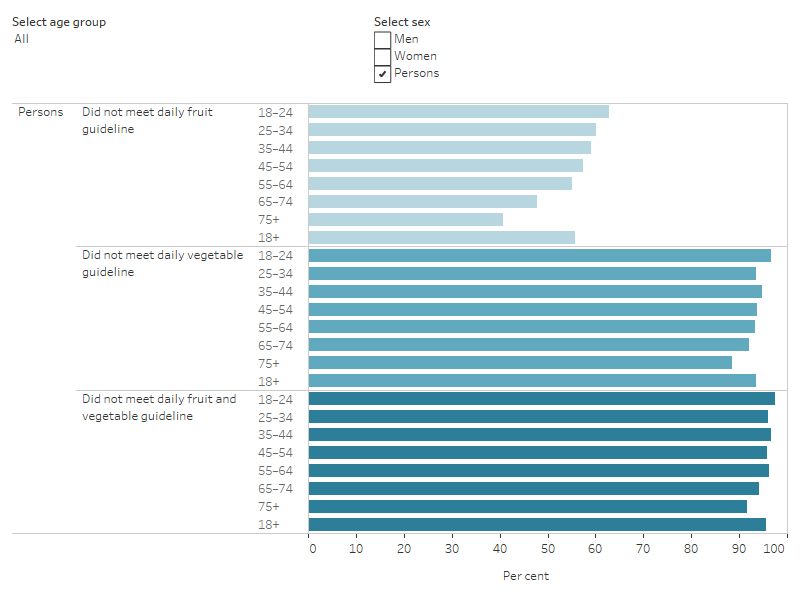Fruit and vegetable intake
The 2013 Australian Dietary Guidelines recommend a minimum number of daily serves of fruit (1–2 for children and 2 for adults) and vegetables (2.5–5.5 for children; 5–6 or more for men depending on age and 5 or more for women) (National Health and Medical Research Council 2013). For more information on the dietary guidelines for different age groups, see the Australian Dietary Guidelines.
Based on self-reported data from the 2022 Australian Bureau of Statistics (ABS) National Health Survey (NHS):
- most Australian adults aged 18 and over (96%) did not meet the 2013 Australian Dietary Guidelines for daily fruit and vegetable intake
- men aged 18 years and over are less likely than women to meet the recommendations for daily fruit and vegetable intake
- the proportion of adults who do not meet the recommendations for daily fruit intake are higher among younger people: 63% of those aged 18–24 compared with 41% of people aged 75 and over
- the proportion of adults who do not meet the recommendations for daily vegetable intake was the highest in those aged 18–24 (97%) but was similar across all other age groups, around 90% (Figure 1).
The age-standardised proportion of Australian adults aged 18 and over not meeting the recommended daily fruit and vegetable intake remained relatively stable between 2007–08 and 2017–18 but has increased slightly in 2022 (AIHW 2024).
See the Diet report for more information.
Figure 1: Proportion of adults aged 18 and over who did not meet the recommended serves of fruit and vegetables, 2022
This bar chart shows that regardless of gender, nearly all adults do not eat enough vegetables, and about half do not eat enough fruit.

# Proportion has a high margin of error and should be used with caution.
Source: Diet (AIHW 2024). For data and footnotes see data table S2 in Diet.
AIHW (Australian Institute of Health and Welfare) (2024) Diet, AIHW, Australian Government, accessed 8 May 2024.
NHMRC (National Health and Medical Research Council) (2013) Australian Dietary Guidelines, Canberra: NHMRC, accessed 1 December 2021.


